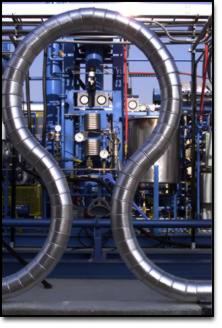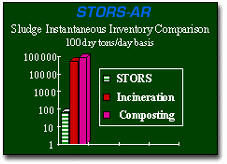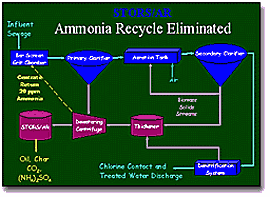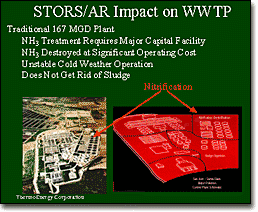|
|
|
Some of the STORS/ARP
process benefits over conventional wastewater
 treatment
methods include: treatment
methods include:
- Onsite Conversion of Sludge to High Energy
Fuels
- Doubles Nitrogen Removal
Efficiency
- Up to 1,000 Times Smaller
Footprint
- Equally Effective as Retrofit or New
Construction
- Significantly Reduces Overall
Disposal Costs
The STORS/ARP process does not
vaporize the water in the sludge (as does incineration, pelletization,
etc.), but chemically converts sludge organics into oil.
The STORS/ARP Revolutionary New
Concept
 Dewatered raw sewage sludge is processed through a hydrothermal
reactor where it is converted into a high-energy oil, char, carbon dioxide
and wastewater. The char is one-tenth the volume of the original dewatered
sludge and can be used as a fuel source on-site or sold to a number of
industries as a power source or cheap feedstock. The oil has 90% of the
heating value of diesel fuel and is sent to an off-site user or refinery.
The carbon dioxide gas is de-odorized and vented. The STORS derived
wastewater, along with the centrate stream coming from the dewatering
process, is sent to the Ammonia Recovery Process ( see Ammonia Recovery
Process heading for detailed description) where the nitrogen, in the form
of ammonia, is converted into one of three saleable commodities-ammonium
sulfate, ammonium phosphate or liquid ammonia - depending on local
regulations, and/or whichever product represents the best commercial value
for that geographical location. Dewatered raw sewage sludge is processed through a hydrothermal
reactor where it is converted into a high-energy oil, char, carbon dioxide
and wastewater. The char is one-tenth the volume of the original dewatered
sludge and can be used as a fuel source on-site or sold to a number of
industries as a power source or cheap feedstock. The oil has 90% of the
heating value of diesel fuel and is sent to an off-site user or refinery.
The carbon dioxide gas is de-odorized and vented. The STORS derived
wastewater, along with the centrate stream coming from the dewatering
process, is sent to the Ammonia Recovery Process ( see Ammonia Recovery
Process heading for detailed description) where the nitrogen, in the form
of ammonia, is converted into one of three saleable commodities-ammonium
sulfate, ammonium phosphate or liquid ammonia - depending on local
regulations, and/or whichever product represents the best commercial value
for that geographical location.
Small Size - Easy
Fit
 The STORS/ARP is a
component system that can be readily integrated into existing wastewater
treatment facilities, freeing up space once used for sludge digestion,
storage or staging area for loading on vehicles for off-site disposal. A
key factor for large urban areas where additional capacity expansion is
desired but the space required by conventional process methods is simply
not available. In addition, by installing a STORS / ARP retrofit, many
municipal wastewater plant operators can actually realize up to a 30%
increase in plant capacity by eliminating the ammonia
recycle. The STORS/ARP is a
component system that can be readily integrated into existing wastewater
treatment facilities, freeing up space once used for sludge digestion,
storage or staging area for loading on vehicles for off-site disposal. A
key factor for large urban areas where additional capacity expansion is
desired but the space required by conventional process methods is simply
not available. In addition, by installing a STORS / ARP retrofit, many
municipal wastewater plant operators can actually realize up to a 30%
increase in plant capacity by eliminating the ammonia
recycle.
STORS/ARP Process Economics
It has long been said that there are only two
drivers in the municipal wastewater industry: compliance and cost. Aside
from being the best available technology for achieving or exceeding local,
state and federal regulatory mandates, the STORS/ARP process will in most
cases, significantly reduce the overall cost of operating a wastewater
treatment plant.

As a
retro-fit, the STORS/ARP process significantly increases both the
available space and process capacity of existing wastewater
treatment plants. | ThermoEnergy's goal is three-fold: To achieve
"zero discharge" status for municipal wastewater facilities, and to
greatly reduce and stabilize the cost of wastewater processing and enhance
our nation's energy independence goals. The STORS / ARP process makes this
goal a reality.
|
|